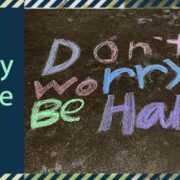Pessimism vs. Optimism – Looking at the Whole Picture
by Margo Ewing Woodacre, MSW
The word, pessimism, was always a bad word to me. It was something that I did not want to be associated with. I was raised by parents who had positive attitudes and taught both my brother and me to find the good things, no matter how difficult life might be. When I would be experiencing a big disappointment or hurt, my mother would remind me, Honey, tomorrow, the sun will come out and things will look brighter! And, a good part of the time, she was right. But as I got older, this philosophy became more perplexing for me.
After graduation, my first job was in New York City in the media field. I found myself working with big-city, aggressive contemporaries who seemed to always look at the glass as half-empty. This was uncomfortable for me. Despite their views, I kept my optimistic outlook and sunny disposition, even when it hurt. To them, I was considered a small-town, naïve enigma.
Later, in my 30’s, I ran for political office and had to develop a much tougher skin to survive. Negative vibes were impossible to avoid as a candidate and an elected official, but no matter what threatened me, I still tried to keep an optimistic view, and was recognized with the “Stop and Smell the Roses,” tongue-in-cheek honor upon my retirement.
Let’s face it, for most of my life, I have been called a “Pollyanna,” due to my defiance of negativity. I don’t apologize for that, as it has carried me through some of my best moments and successes. However, when things did not go as well, it was uncomfortable and hurt deeply and I questioned why life took such a turn. It was puzzling for me to understand why looking through the optimistic lens of life did not always turn out as expected or make me feel happy. Why?
In creating my Beyond the Now program, it was my research, along with an article, When Hope Meets Reality, written by Gary Burnison, CEO of Korn Ferry, that I had an Aha! moment.
According to Burnison, it is best to have a balanced view of both optimism and pessimism – which he calls, Healthy Pessimism. With a totally optimistic view, too much of a good thing can be too much—even when it’s hope. Pessimism forces us to see reality, which actually may allow us to reframe the picture, to then instill hope that we will make tomorrow better than today. When critical things happen, seeing the reality (pessimism) keeps us grounded, while the hope (optimism) keeps us inspired.
In my case, I may have been aware of the whole picture, but I refused to see anything but the good interpretation (the optimistic view). I needed to take a more realistic look at the big picture with both lenses. I now realize that by filtering out the negativity (the pessimism), I was not eliminating it, but actually stuffing it. This is what caused my discord.
I am thankful that Mom and Dad taught me to see the glass half-filled vs. half-empty, but I am glad to now see the whole glass! Having this healthier balance is important for living and dealing with life, especially in the world we live in. In challenging times ahead, I still may lean toward the more optimistic view, but Healthy Pessimism is what I will strive for!











